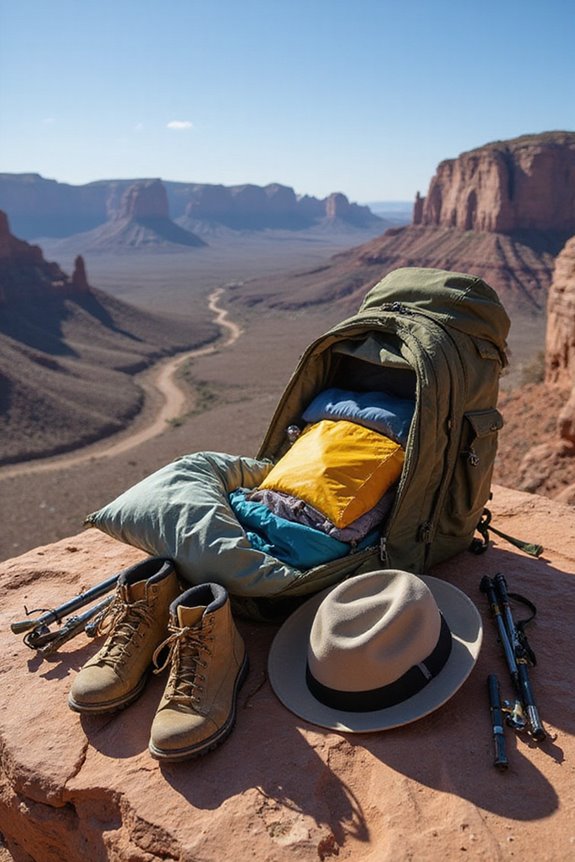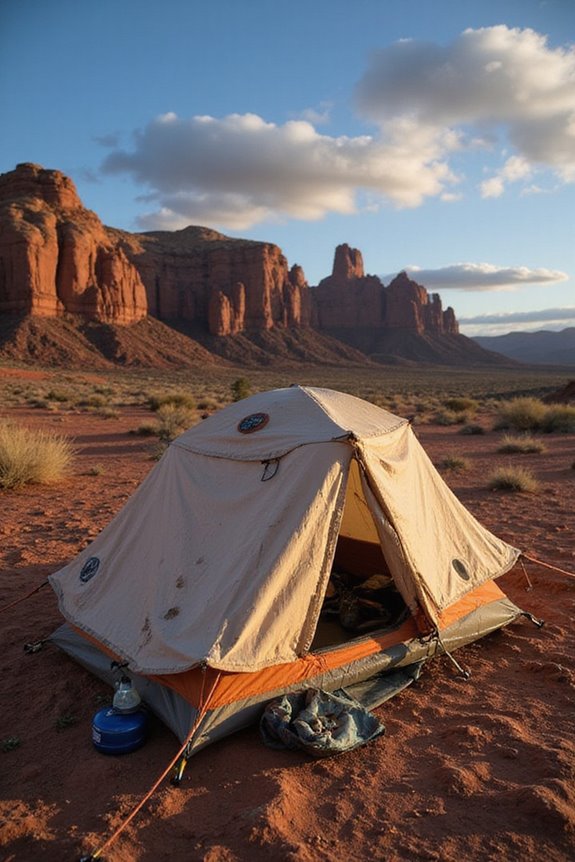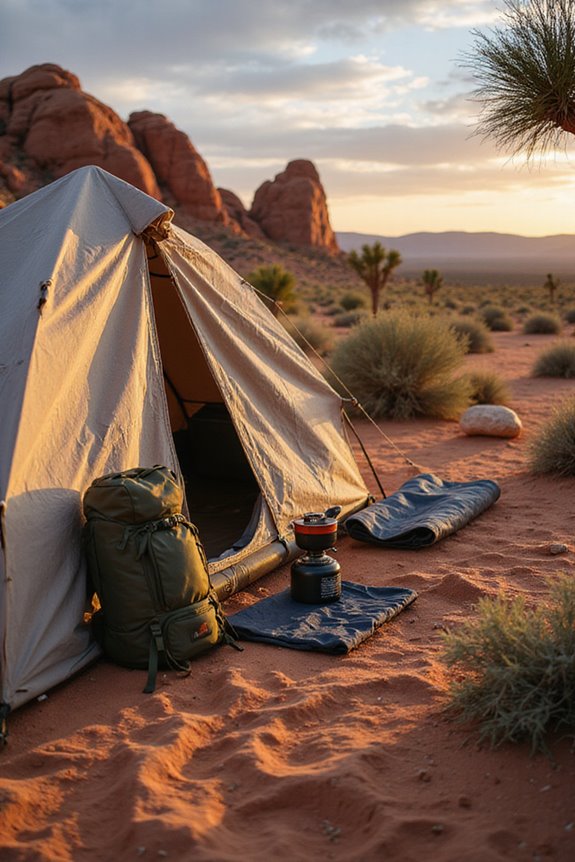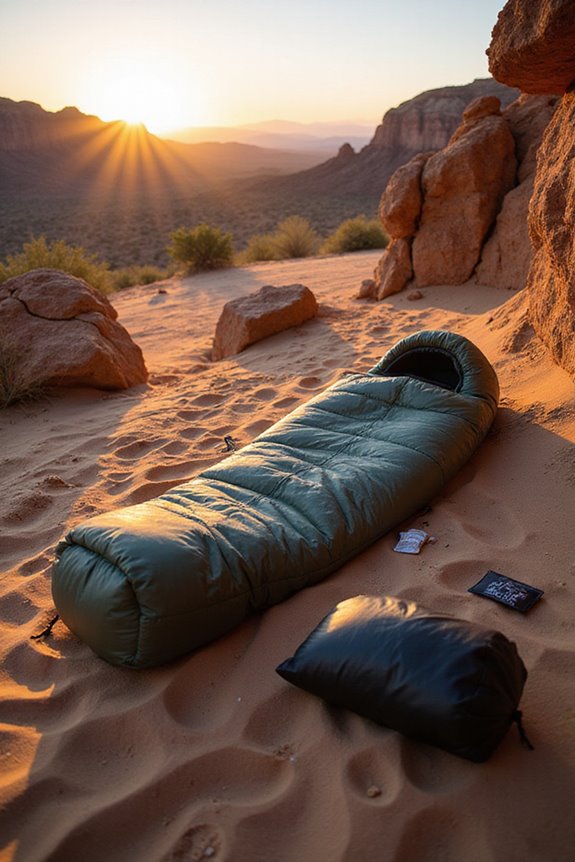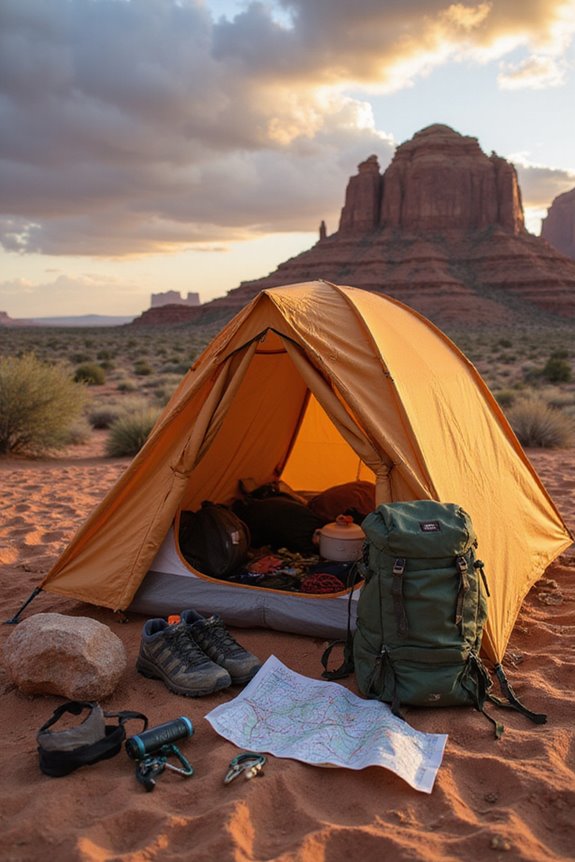When we head out for backpacking, packing smart is our secret weapon! We need cozy quilt shelters, lightweight tarps, or hammocks for a comfy night’s sleep. Don’t forget a solid backpack (40-65 liters) to haul it all along. Moisture-wicking clothes and warm layers keep us dry and toasty. Hydration packs and calorie-dense snacks fuel our adventures. And let’s not skip tools like a trusty multi-tool! Stay with us, and we’ll tackle all the essentials you’ll need.
Key Takeaways
- Choose a lightweight backpack (40-65 liters) with a good suspension system and smart storage solutions for essentials.
- Pack a cozy quilt shelter, hammock, or bivy sack for comfortable sleeping arrangements under the stars.
- Bring moisture-wicking base layers, a light fleece or down jacket, and sturdy hiking boots for proper clothing and footwear.
- Include a hydration pack and calorie-dense food options, with a backpacking stove for efficient camp cooking.
- Don’t forget navigation tools like a map and compass, along with repair tools, a headlamp, and trekking poles for stability.
Shelter & Sleeping System
When it comes to packing for a backpacking trip, choosing the right shelter and sleeping system can make or break our outdoor adventure! Picture us under the stars with a cozy quilt shelter or securely nestled in a bivy sack, ready for whatever nature throws our way. Tarp shelters? They’re lightweight and customizable, ideal for those wild nights when the weather turns. Hammock setups elevate our sleep game, though we’ve gotta watch those pesky mosquitoes! Between sleeping bags that keep us toasty at 20°F and sleeping pads that feel like clouds, comfort considerations are key. Let’s not forget the insulation systems—we’ll want to layer up for those chilly nights. For optimal comfort while hiking, consider lightweight mummy sleeping bags weighing around 3 pounds that offer tapered designs to retain body heat without excess space. Adventure awaits, and we’ll sleep well in our chosen refuge!
Backpack & Storage
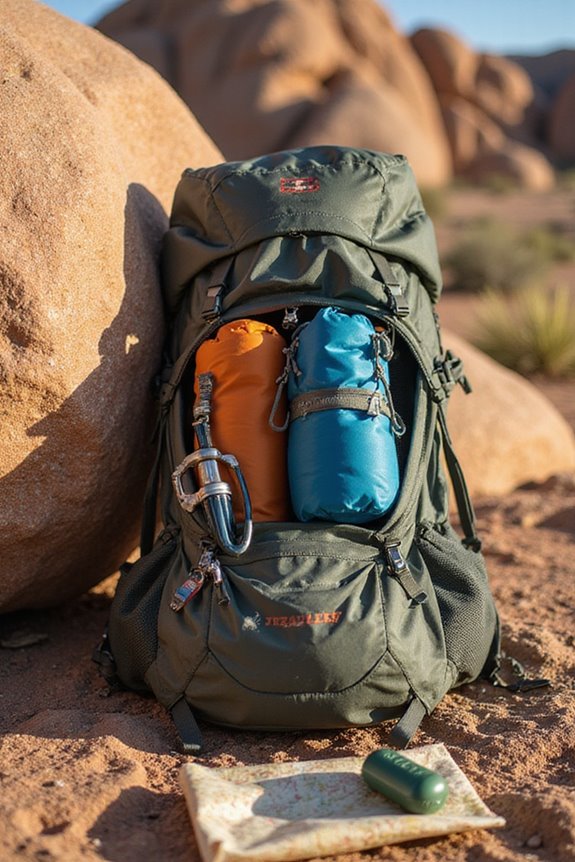
Choosing the right backpack for our adventures can feel like a quest in itself, but trust us, it’s worth every ounce of effort! Whether we’re tackling a multi-day hike with a 40-65 liter pack or going for a quick day trip, the right backpack types make all the difference. We need durable materials like ripstop nylon to lighten the load, plus a great suspension system to keep our shoulders happy while we roam free. For day hikes, look for lightweight options that weigh between 1 to 3.5 pounds for optimal comfort without sacrificing durability.
For smart storage solutions, think compartments and pockets. Let’s keep food, electronics, and clothing separate to avoid chaos. And don’t forget about those convenient external attachment points—for our trekking poles and snacks! With the right pack, we’ll be ready to conquer any trail the wild throws our way!
Clothing & Footwear
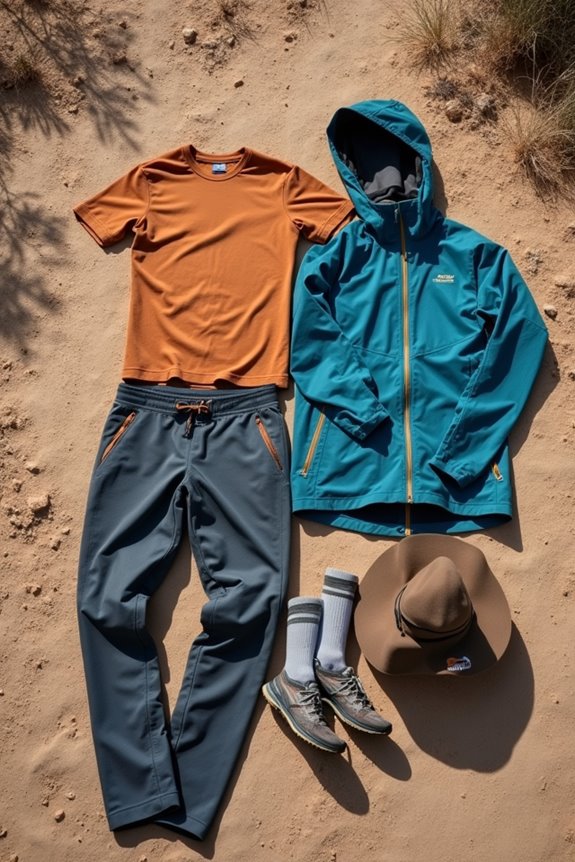
Strapping on the right clothing and footwear for our backpacking adventures can be the difference between a memorable trek and one you’re just keen to forget. We’ve learned that layering techniques are our best friends. Start with moisture-wicking base layers in synthetic or wool to keep us cool and dry. A light fleece or down jacket for chilly moments is essential; trust us, it’s a game changer. Look for fleece jackets with multiple pocket designs that provide secure storage for essentials like snacks and maps during your hike. As for footwear, comfortable, well-broken-in hiking boots with solid traction make tackling steep trails a breeze. We never forget our high-quality socks—no cotton, please! And hey, a good sun hat? That’ll keep those temperatures at bay. Pack smart, and let’s embrace the freedom of the wild!
Hydration, Food & Cooking
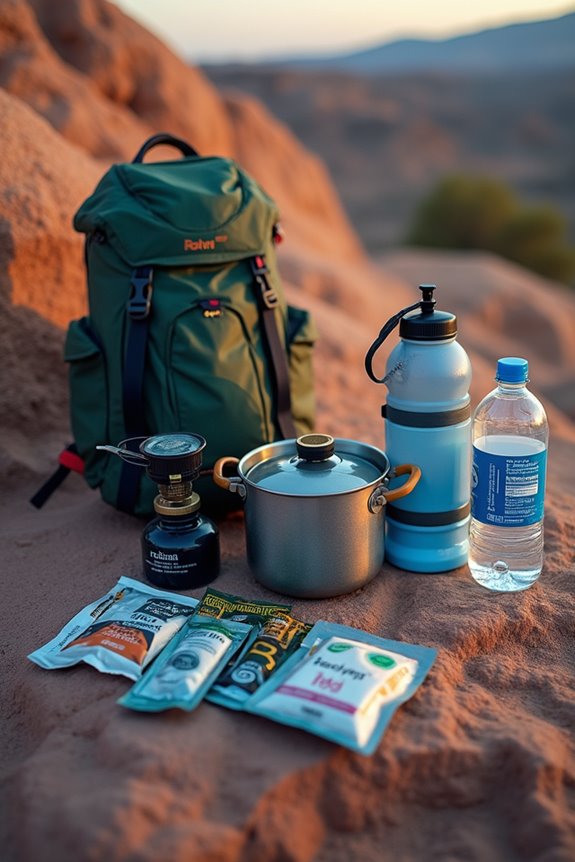
Staying hydrated and well-fed is just as essential as keeping your pack light! We can’t emphasize enough the importance of good hydration strategies. A hydration pack with features like bite valves and quick-disconnect tubing is a game-changer on the trail, allowing us to sip easily without stopping.
When it comes to food packing, we recommend calorie-dense options—think trail mix or energy bars. Packing about 2 to 2.5 pounds of food per person per day keeps our energy levels soaring without weighing us down. Sharing food on group hikes can lighten our loads, too! And don’t forget lightweight cooking equipment for those cozy camp meals. We love the magic of gathering around a stove after a long day’s hike, savoring every bite! For efficient cooking, look for backpacking stoves with at least 3000W heat output to ensure your meals are prepared quickly even in challenging outdoor conditions.
Tools & Accessories
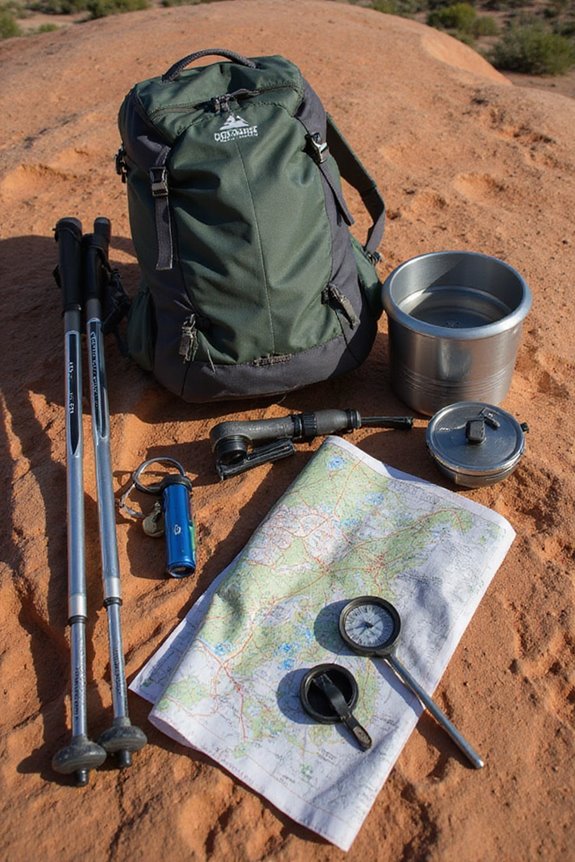
When you’re out there on the trail, the right tools and accessories can make all the difference, especially when your beloved GPS decides to take a nap! We can’t stress enough how crucial a good map and compass are—trust us, they won’t run out of batteries.
Don’t forget our trusty repair tools like multi-tools and duct tape. They’ve saved our gear more times than we can count! Cooking accessories? A long handle spoon and lightweight stove are game-changers for whipping up warm meals after a long hike.
And hey, a headlamp is essential for those unexpected night-time adventures. For added stability on challenging terrain, consider investing in adjustable trekking poles that can be customized to your height and folded for easy storage. With these essentials in our packs, we’re ready to embrace the freedom of the wild and tackle whatever challenges come our way!
Safety & Emergency Kit
Having a solid safety and emergency kit is like carrying a lifeline in the wild—totally essential! We need the right first aid essentials: adhesive bandages, antiseptic wipes, and over-the-counter pain relievers for those unexpected scrapes and sneezes. Don’t forget nitrile gloves; they keep things clean when the wilderness gets messy!
For emergency shelter, packing a heat-reflective blanket or lightweight tarp can save us from cold nights. Plus, fire-starting tools are a must!
To signal for help, a slim rescue whistle and mini reflective mirror are game-changers. They’re our best friends when we need attention.
Navigation & Communication Tools
Whether we’re trekking through rugged mountains or wandering along serene forest paths, having the right navigation and communication tools is essential for our adventures. We can’t rely solely on our sense of direction! A trusty GPS device helps us track our route, while a magnetic compass always points true north, no matter how lost we might feel. Altimeter watches are great for confirming our elevation in those soaring peaks. Let’s not forget satellite messengers and personal locator beacons—they’re our lifelines in emergencies when reception goes MIA. Always pack navigation backups like maps, pencil, and paper, because technology doesn’t always play nice. After all, a little communication safety goes a long way in ensuring our epic escapades have happy endings!
Frequently Asked Questions
How Do I Choose the Right Backpacking Route?
Choosing the right backpacking route’s all about knowing our limits. We’ll consult backpacking maps, assess route difficulty, and seek trails that ignite our sense of adventure while aligning with our skill levels and desires for freedom.
What Wildlife Precautions Should I Take While Backpacking?
We’ve heard stories of friends encountering bears while camping, emphasizing bear safety. Let’s stay alert and aware, remembering to keep an eye out for snakes. Together, we’ll explore responsibly and enjoy our adventures freely!
How Can I Minimize My Pack Weight?
To minimize our pack weight, let’s invest in ultralight gear and focus on weight distribution. We’ll choose versatile items that serve multiple functions, allowing us to roam freely without feeling weighed down by unnecessary burdens.
What Should I Do in Case of an Emergency?
In case of an emergency, we should check our first aid kit, contact emergency numbers, and guarantee everyone knows our plan. Keeping emergency contacts handy helps us stay connected while enjoying our freedom in the outdoors.
How to Manage Sanitary Needs While Backpacking?
When we hit the trail, managing our sanitary needs is key to staying fresh. Packing essential sanitary supplies and practicing proper hygiene keeps us feeling free and confident, letting us fully enjoy the adventure ahead.

